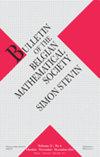离散Cesàro空间的对偶Banach空间诱导的fr和(LB)序列空间
IF 0.6
4区 数学
Q4 MATHEMATICS
Bulletin of the Belgian Mathematical Society-Simon Stevin
Pub Date : 2021-05-01
DOI:10.36045/J.BBMS.200203
引用次数: 5
摘要
法国人(代表)。, (LB)-)序列空间ces(p+):= r>p ces(r), 1≤p <∞(resp;Ces (p-):= 1Fréchet and (LB) sequence spaces induced by dual Banach spaces of discrete Cesàro spaces
The Fréchet (resp., (LB)-) sequence spaces ces(p+) := ⋂ r>p ces(r), 1 ≤ p < ∞ (resp. ces(p-) := ⋃ 1
求助全文
通过发布文献求助,成功后即可免费获取论文全文。
去求助
来源期刊
CiteScore
1.00
自引率
0.00%
发文量
14
审稿时长
6-12 weeks
期刊介绍:
The Bulletin of the Belgian Mathematical Society - Simon Stevin (BBMS) is a peer-reviewed journal devoted to recent developments in all areas in pure and applied mathematics. It is published as one yearly volume, containing five issues.
The main focus lies on high level original research papers. They should aim to a broader mathematical audience in the sense that a well-written introduction is attractive to mathematicians outside the circle of experts in the subject, bringing motivation, background information, history and philosophy. The content has to be substantial enough: short one-small-result papers will not be taken into account in general, unless there are some particular arguments motivating publication, like an original point of view, a new short proof of a famous result etc.
The BBMS also publishes expository papers that bring the state of the art of a current mainstream topic in mathematics. Here it is even more important that at leat a substantial part of the paper is accessible to a broader audience of mathematicians.
The BBMS publishes papers in English, Dutch, French and German. All papers should have an abstract in English.

 求助内容:
求助内容: 应助结果提醒方式:
应助结果提醒方式:


